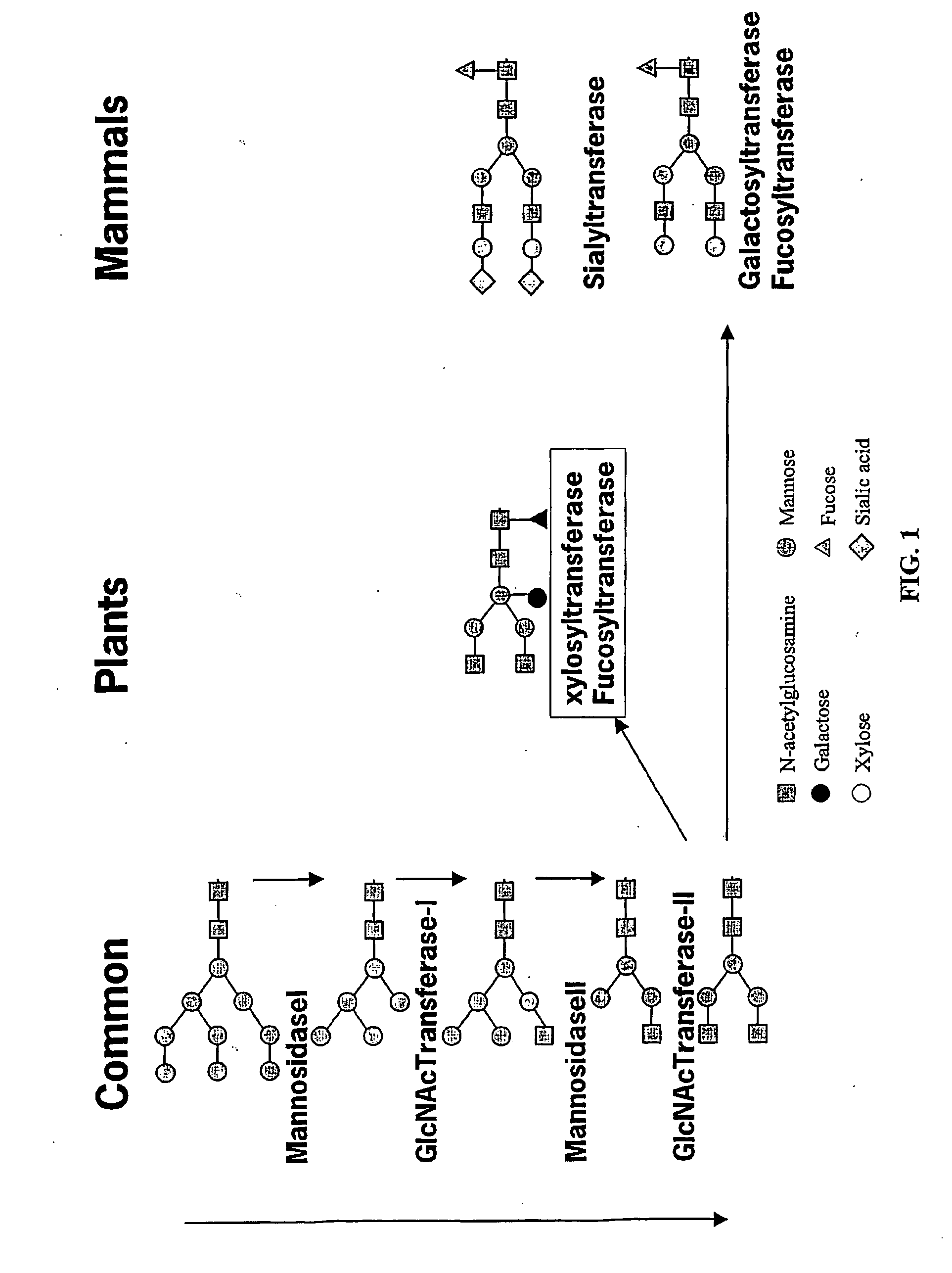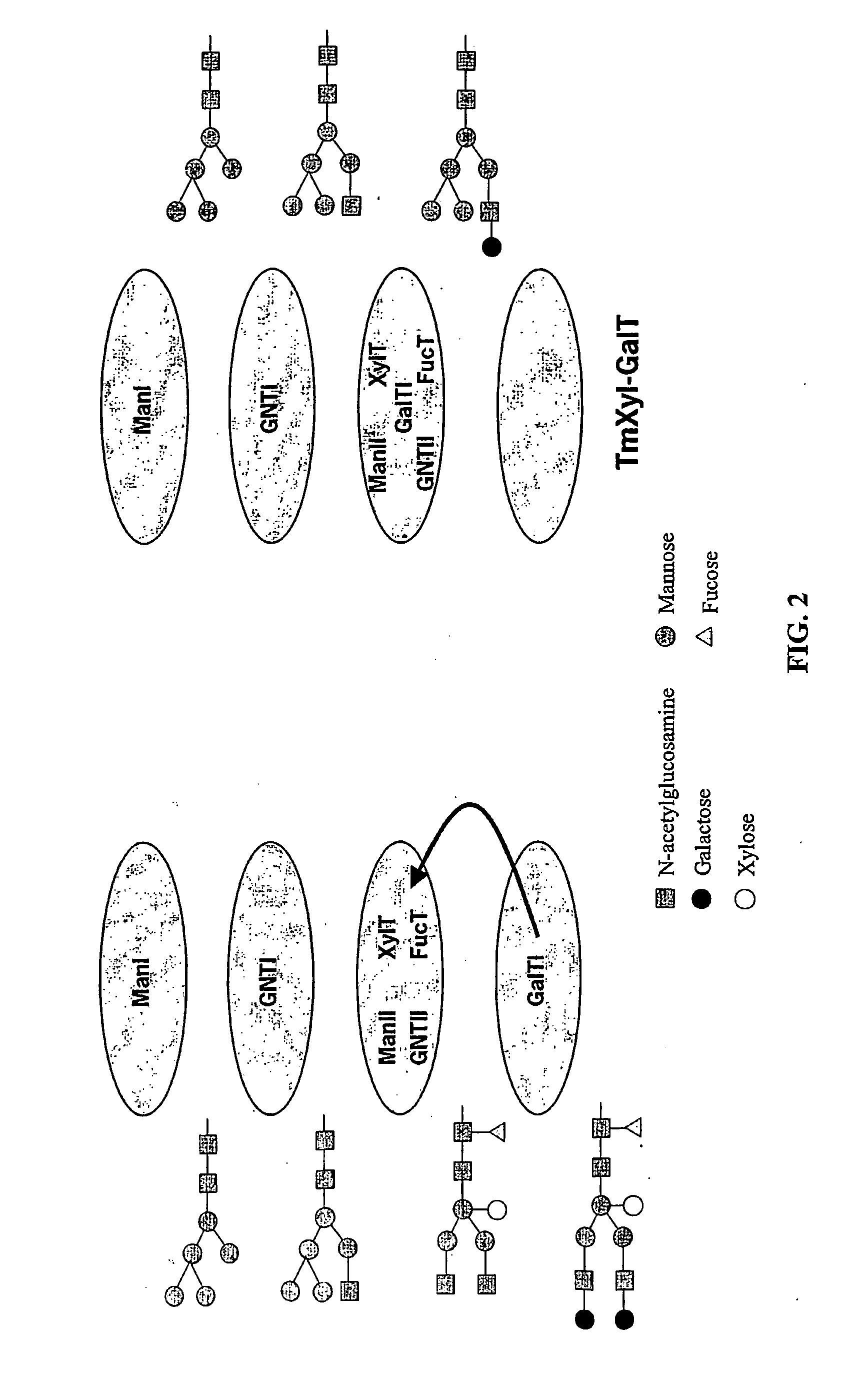Optimizing glycan processing in plants
a technology of glycans and plants, applied in the field of optimizing glycan processing, can solve problems such as false positive reactions, and achieve the effect of reducing the overall diversity of glycans
- Summary
- Abstract
- Description
- Claims
- Application Information
AI Technical Summary
Benefits of technology
Problems solved by technology
Method used
Image
Examples
example 1
[0164] An Arabidopsis thaliana cDNA encoding β1,2-xylosyltransferase was isolated from a cDNA library by a previously described PCR based sibling selection procedure [Bakker et al., BBRC 261:829 (1999)]. Xylosyltransferase activity was confirmed by immunostaining of transfected CHO cells with a xylose specific antibody purified from rabbit-anti-horseradish-peroxidase antiserum. A DNA fragment covering the N-terminal part of the xylosyltransferase was amplified using primers:
XylTpvuF:ATACTCGAGTTAACAATGAGTAAACGGAATC(SEQ ID NO: 45)andXylTpvuR:TTCTCGATCGCCGATTGGTTATTC(SEQ ID NO: 46)
XhoI and HpaI restriction sites were introduced in front of the start codon and a PvuI was introduced at the reverse end. A C-terminal fragment from Human β1,4galactosyltransferase (acc.no. x55415, Aoki 1992) was amplified using primers GalTpvuF:GCCGCCGCGATCGGGCAGTCCTCC (SEQ ID NO:47) and GalTrev:AACGGATCCACGCTAGCTCGGTGTCCCGAT (SEQ ID NO:48) thus introducing PvuI and BamHI sites. The XhoI / PvuI and PvuI / Bam...
example 2
[0166] A transgenic plant expressing said TmXyl-GalT gene (TmXyl-GalT-12 plant) was selected (above) based on lectin blotting using biotin-labelled RCA (Vector Laboratories, Burlingame, Calif.). Comparison of protein extracts of MGR48 transgenic (control) plant, a selected transgenic plant expressing the unmodified human β1,4-galactosyltransferase gene and TmXyl-GalT-12 plant for the presence of xylose and fucose using anti-HRP (horseradish peroxidase) polyclonal antibody (known for high anti-xylose and anti-fucose reactivity) clearly showed reduced xylose and fucose (FIG. 34: “Anti-HRP”). Western blotting using an anti-xylose fraction of the anti-HRP and an anti-fucose fraction (each of which can be prepared by affinity chromatography over the appropriate ligand) showed that especially xylose was reduced compared to control plants (FIG. 34: anti-Fuc” and “anti-Xyl”).
example 3
[0167] The TmXyl-GalT-12 plant was crossed with a transgenic plant expressing the monoclonal antibody MGR48 from a single T-DNA integration event (MGR48-31) and which was first made homozygous by selecting offspring plants not segregating for the kanamycin resistance marker and antibody production (MGR48-31-4). Pollen of MGR48-31-4 was used for pollination of emasculated TmXyl-GalT-12 plants. Vice versa, pollen of TmXyl-GalT-12 plant was used for fertilization on emasculated MGR48-31-4 plants. A number of F1 plants were analyzed for the presence of MGR48 by western blotting and for galactosylation of endogenous glycoproteins by lectin blotting using RCA (FIG. 35). One plant expressing MGR48 and showing galactosylation of endogenous glycoproteins was selected for further analysis. This plant was identified as XGM8.
[0168] Seeds from TmXyl-GalT-12 (♀)×MGR48-31-4 (♂) were sown and F1 offspring plants (XGM) were analysed for antibody production by Western blotting and for galactosylatio...
PUM
| Property | Measurement | Unit |
|---|---|---|
| Fraction | aaaaa | aaaaa |
| Fraction | aaaaa | aaaaa |
| Force | aaaaa | aaaaa |
Abstract
Description
Claims
Application Information
 Login to View More
Login to View More - R&D
- Intellectual Property
- Life Sciences
- Materials
- Tech Scout
- Unparalleled Data Quality
- Higher Quality Content
- 60% Fewer Hallucinations
Browse by: Latest US Patents, China's latest patents, Technical Efficacy Thesaurus, Application Domain, Technology Topic, Popular Technical Reports.
© 2025 PatSnap. All rights reserved.Legal|Privacy policy|Modern Slavery Act Transparency Statement|Sitemap|About US| Contact US: help@patsnap.com



